I finally rid myself of this bad boy last spring.
I left that gas mower out on the street for the City of Austin’s twice annual large waste pickup, where I’m assured it will be dismantled in a responsible manner. At least that’s what they say and I choose to believe them. I haven’t used a gasoline powered mower for 8-10 years. Its oil and gas long since drained and properly disposed of, I can only attribute to laziness my not having scrapped the mower before now. I ended the last patch of grass on my property in 2011–you can read about that process here.
Instead of grass there is now a simple swath of pea gravel, bordered by perennial gardens and the cooling, restful pond.
I drool over photos of the extravagant and creative walkways I see on garden blogs and in garden literature, but I have to be practical with my walkways.
My dog, Asher likes to roll in mulch so that pathway product is out of contention because of the mess engendered. He also enjoys rolling in pea gravel.
But pea gravel is cleaner than mulch and I don’t mind walking bare-foot on it, so that’s the medium I’ve chosen for two open, negative spaces and one pathway in my back garden. The maintenance is easy and pea gravel has a tidy appearance.
This area was once entirely turf,
…and this one, too.
In fact, my whole back yard was lawn. Now the area is a low-maintenance, no-lawn alternative. There is no turf and no grass. There is nothing left in my back gardens which needs heavy-duty weekly upkeep or irrigation.
Instead, lovely perennials, shrubs and ornamental grasses,
…with accompanying pathways fill this once sterile place.
This front part of my Slice of Paradise was all St. Augustine grass for many years.
But for the past 8-10 years, it’s promoted perennials and hosted plants for wildlife, while providing herbs and vegetables for my family.
The main section of my front yard was entirely St. Augustine grass until 18 years ago. I added a border garden stretching along the street side and up the driveway to enclose the space. After a cold winter 16 years ago which killed the St. Augustine grass, I expanded the garden inward toward the center of the lot. For many years, I mulched the open space, resulting in a restful sitting are where we enjoy the garden, mosquitoes notwithstanding.
I admit that I came to miss the green expanse that turf lends to a garden space. I didn’t want to install grass because most lawn varieties are water-needy and wasteful. Most turf doesn’t feed any wildlife, and it requires mowing and fertilizing. None of that for me!
A while back, I noticed Horseherb, Calyptocarpus vialis, popping up in crooks and crevices around my gardens, or more correctly, in pathways around my gardens. I don’t know where it came from, but I like Horseherb also call Straggler Daisy.
Rough-textured foliage, with tiny, sunny-yellow flowers, some years it blooms more than others. This year, hardly at all.
Horseherb is a drought-tolerant, hardy native ground cover which accepts shade and moderate foot traffic. While I didn’t mind it spreading in my garden space, I was attempting to keep it under some control. As I was yanking out some Horseherb (which has returned…) from the crack between the driveway and this raised bed,
I thought: Why can’t I use the Horseherb as a ground-cover in that sitting area? There’s no reason this can’t be transplanted.
So I did!
I’m pleased with this project. The Horseherb nearly filled the space last summer, though with the cold winter of 2013-14, it’s returned slowly and unevenly.
I transplanted some of the clumps of Horseherb very late last fall–I believe there wasn’t sufficient root establishment for those particular plants and that’s why it didn’t return after the hard freezes. Also, I haven’t transplanted any new clumps this year to replace the lost Horseherb. If I had, this area would be completely filled in by now.
I watered it three times last summer and so far, not at all this summer. I probably should water at this point, but it certainly doesn’t need the weekly irrigation that the typical lawn would require.
Two downsides of using Horseherb as a “lawn” ground cover are, 1) it needs trimming along the edges to prevent encroachment into the garden, and 2) it’s not evergreen. Those minor issues aside, Horseherb allows me some green expanse of lawn that had I missed and desired.
However, I do have to mow it. So I use this not-so-bad-of-a-boy for that job.
A friend gave me this old-fashioned, human propelled push mower a few years ago. It’s perfect for the tiny area which needs mowing and I don’t waste fuel when using it. Tina-powered calories fuels the mowing and I’m always happy to spend of a few of those.
I don’t live in a gardening-centric neighborhood. I’m dismayed when I see homeowners replace dead grass with the same, or similar, grass. In my neighborhood, that happens all too often. (What’s the definition of insanity? Making the same mistake over and over?) With the reality of increasing limits on water usage faced by urban areas, here in Austin and elsewhere, homeowners will need to remove water-hogging turf and install usable pathways and native/well-adapted perennials. The market is also expanding for commercial drought-tolerant lawn substitutes–there’s more than just St. Augustine and Bermuda grass to choose from. Practical lawn alternatives support water conservation, can (and should!) promote wildlife gardening, and are easy to maintain.
Lawn alternatives are at least as attractive as a stretch of green lawn, if not more so.
I wish the less lawn revolution was happening more quickly, but it is happening. I’ve never regretted ditching my lawn so long ago. If you want to read about my yard transformation, click here.
No more bad boy turf for this gardener!
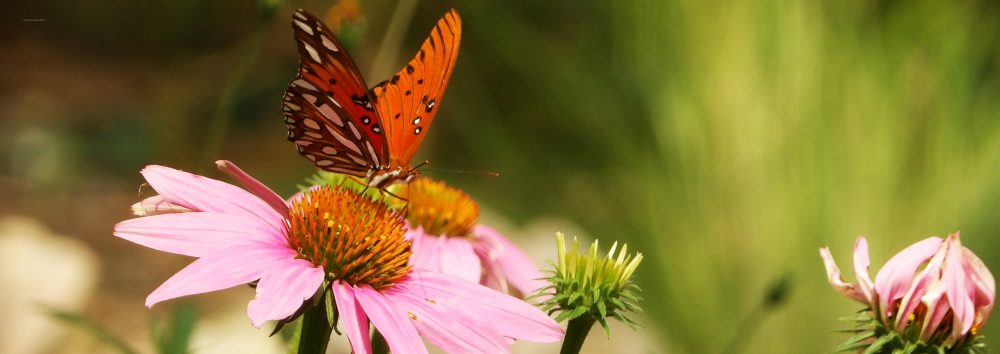
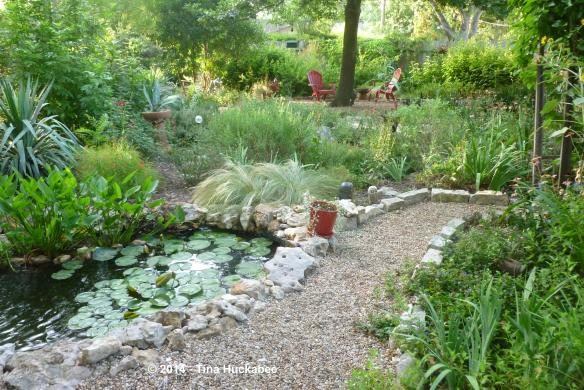




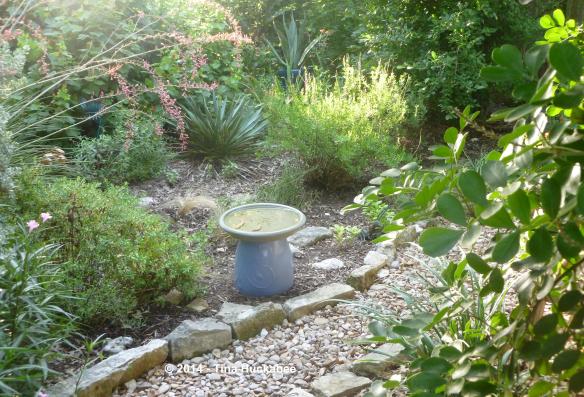




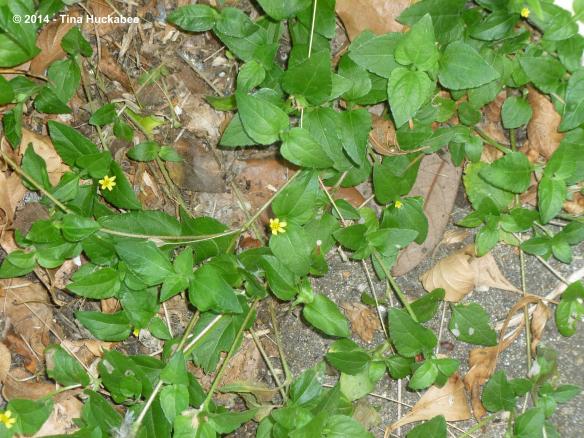

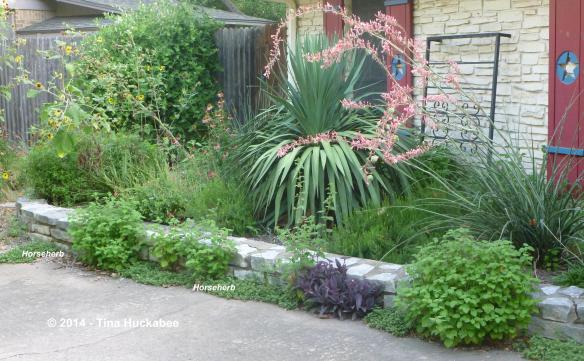
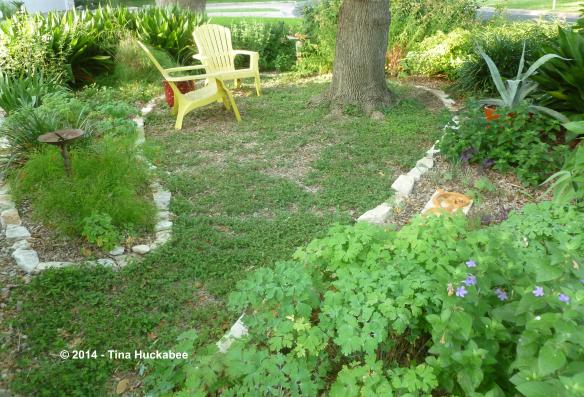

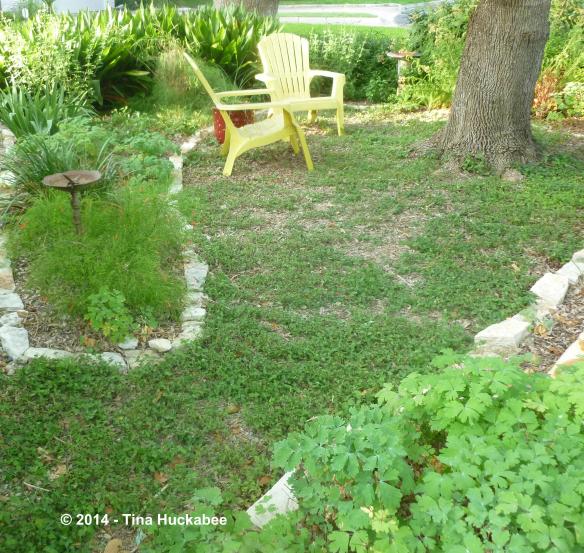

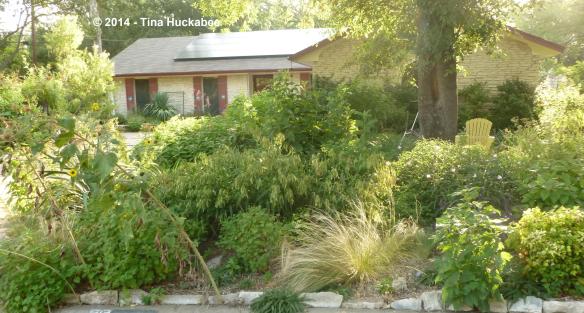
Your example inspired me when I lived in your ‘hood, Tina, and I’m happy to see you inspiring others as well with posts like these!
LikeLike
Thanks, Pam! I wish more of my neighbors would plant more perennials and waste less water. In time, they’ll be forced to, but it’s too bad that can’t happen sooner. Hopefully, those of us who see the value of conservation will continue to inspire. Hopefully.
LikeLike
I have started a conversion but find the cost of good drought tolerant perenials to be prohibitive, at least the numbers that I need to buy. plus all the other hardscaping that needs to accompany it. So, it will be done slowly. Unfortunately our grass is dying faster than my pocketbook can keep up. So we will be mowing weeks for a while.
LikeLike
Hi Lyn! It will take time. This sort of lawn-to-less-lawn conversion is not something done in a weekend. And, it’s work. Eventually, you’ll plant perennials and shrubs and they’ll reproduce–that’s where I get most of my plants. They pop up as seedlings and I transplant them to other places. I use many plants over and over, in repeated vignettes, in my gardens. I also share with other gardeners and they share with me. Most native and well-adapted plants (from more local nurseries usually–the big-box stores aren’t quite as hip to what’s appropriate for a given area) can be purchased as 4 or 6 inch pots and those are usually only a couple of dollars each. The one place where I spend serious money is if I’m purchasing a tree or a very slow-growing shrub. Also, late summer/fall (here in Central Texas) is the best time to shop and plant; often you can buy plants on sale and what you plant has a long time to establish roots before our typical difficult time of year–now–late summer. It’s true that planning for and installing hardscape can be costly, but you have to think long-term. Do you want to continue to water/mow/fertilize something that is wasteful and is expensive to maintain year-in/year-out or do you want to invest in a “product”–a regionally appropriate landscape, which will, over time, be less expensive and less maintenance? Good luck to you and you’re headed on the right track!
LikeLike
Your spaces ARE inspirational! Thanks so much for sharing the wide shots – I love the chance to get a peek at the overall views there. We still have one small patch of St. A out back, it is The Hub’s desire to keep it so for the moment it stays. Everywhere else has the grass has been replaced with a mix of mostly perennials, mostly natives, but all plants less thirsty than the lawn. We’ll convert our neighborhoods yet by golly!
LikeLike
Thanks, Deb! You know, I think it’s fine to leave some grass–it can be very appropriate and even necessary (for kids to kick a ball or for a dog to romp). It’s just those large, thoughtless, water-hogging lawns–they make me nuts!! And watering the curb and driveway? Don’t even get me started on that!! On with the revolution!
LikeLike
Love those long views. It all looks great.
We have just a small amount of lawn in the fenced area. We have an electric, toy-sized mower, that takes about five minutes of work.
In the rest of the yard, we have rye grass from the golf course in winter, and horse herb in summer. It’s all pretty crispy right now.
I have more hardscape planned. Just needs the doing.
LikeLike
Thanks, Linda. Good for you and your electric mower! That “doing” thing can be difficult at times, especially this time of year.:) It’ll cool off soon. Maybe.
LikeLike
Your gardens are gorgeous! I still grow St. Augustine even though I know it isn’t fashionable. In my experience it isn’t thirsty at all … it does really well in clay soil under the tree cover in near total shade. I never irrigate my backyard and that lawn survived the great drought. For me it meets the xeric test though not the wildlife friendly one. Eventually I plan on replacing it but for now it isn’t a priority. I admit to giving water once every 2 weeks in the front but only because I don’t want the heritage pecans to die. I wonder if the water hog reputation comes from people trying to grow it in sun? And I love love my push mower. Quiet, light-weight. In every way it is superior to gas powered and electric powered machines. It is a dream. Unfortunately, it is also a people stopper. It never fails that when I go out to cut the grass someone will stop and ask about it. They think it is primitive and seriously weird. I don’t mind too much because I feel I can plant the seed of using a non-fossil fuel based machine but really one day I hope to be able to mow in peace. =)
LikeLike
“Seriously weird”–I love it!! That’s what most of my neighbors think I am. They’re not wrong. You’re absolutely spot on when you say that your St. Augustine is drought tolerant–in shade, with (I assume), little traffic. I actually kept my St. Augustine for a while–in both “circles” in the back and the area in the front. In the back yard, I didn’t water it much, but I had a dog who rolled and rolled in the grass and it became patchy, at best. The grass, not the dog. 🙂 That’s when I decided to rid myself of it. I could have watered it out the wazoo, but yeah, I wasn’t going to to that. I mulched it (dog issues again) then pea graveled it. That works for us. In the front, because I didn’t water it, I lost it to a hard, very dry winter 16 years ago. I didn’t replace it. St. Augustine is fine for shade and you’re correct when you state that it’s the folks who have it in full sun and want it Irish green who are the problem. Keeping St. Augustine grass that green in full Texas sun is a tremendous strain on our water supply. I just think there are better choices and I hope others will too. Eventually.
LikeLike
Congratulations on getting rid of the mower Tina. Your garden areas look inviting and relaxing. Gardening is so much more fun than mowing.
We have a huge swath of horseherb in the back yard. Because it dies back annually we don’t mow it but I can imagine that a rainy year might mean we would need to.
LikeLike
Shirley, you’re right! Gardening is so much more fun and rewarding than mowing. I think I remember you posting about your large area of horseherb. It’s a great ground cover. Another good choice for a hardy ground cover is frog fruit. I’ve seen that instead of turf and it works well too.
LikeLike
If you look closely at the plant, shortly after the flower dies it leaves a small cluster of seeds which look much like the flower itself. They are beige color and you can easily pull them off when they’re ready to sow. Just take a few clusters off, mix them with sand then scatter them into your lightly tilled soil. They grow quickly. Keep them watered while they’re young and tender. Don’t walk on them till they’re nice and established too.
LikeLike